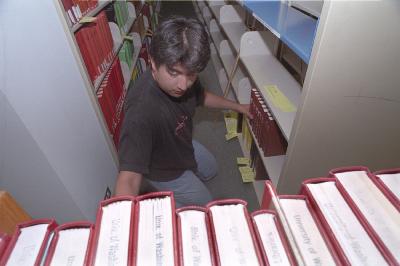August 19, 2004
Bloedel’s Forest Resources library to fold into Allen’s Natural Sciences Library
The task might sound simple enough — at first, that is. Just blend the smaller library into the bigger one.
That is, take all the books and periodicals in the soon-to-close Forest Resources Library in Bloedel Hall, and combine them with the books and periodicals at the Natural Sciences Library, in the south wing of the Allen Library, their new permanent home.
Laborious, maybe even tedious, but pretty straightforward, right? Not so fast, there are a few factors to consider.
We’re talking about 40,000 books and periodicals here. How and where should the receiving library make room for them, and how should the items be arranged to best serve the users? And how can it all be done in a way that minimizes down-time for the information they need?
Oh, and periodicals and books are generally shelved in different areas — but is it helpful to make people look in two places for information on a single theme? And then there are the two major classification systems. The Dewey Decimal System, which everyone remembers from grade school and public library visits, doesn’t accommodate change and expansion as well as the Library of Congress system — yet many of the titles to be moved are only classified by Dewey, and so they need to be reclassified and relabeled as well as moved.
Such complicating factors are why there is a color-coded chart on the wall of a work room in the Natural Sciences Library that shows exactly where everything will go during this bibliographic merger, which will begin on Aug. 23. The chart was created — by pushing the envelope of an Excel program — by Stephanie Wright, a temporary library employee with the formidable but self-explanatory job title of Natural Sciences/Forest Resources Merger Manager.
Wright is working under the direction of Nancy Blase, head of the Natural Sciences Library, and Steve Hiller, head of all the science libraries at the UW. Hiller said it was decided early last summer by UW Libraries Director Betsy Wilson in consultation with Dean Bruce Bare of the College of Forest Resources to fold the smaller unit’s collection into the larger, newer Natural Sciences Library. In all, about 50 library employees will participate in the move.
Budget-tightening is one reason for the merger, Hiller said, and reduced usage is another. The Forest Resource Library ranked next-to-last among campus libraries in printed items used and in reference and information questions in the last fiscal year. He said the move is expected to take about 10 days and cost in the neighborhood of $40,000 to $50,000, but that with staff changes and reduced operating costs, up to $100,000 per year could be saved. Hiller and Blase stressed, however, that no layoffs will result from the move, and that they understand the sense of loss to those in the college community.
Blase called the move “a once-in-a-lifetime opportunity” to get the reclassifying and restocking done all at once. She and the others also decided to group materials by subject, so that books and periodicals on a single subject would be close together.
“Because we had to shift the collection to make room for Forestry anyway, this was an opportunity to reclassify and shift the collection with the new Library of Congress call numbers, and to merge the books and periodicals together,” Blase said. “The whole purpose is that they make the collection better for the library users.”
Wright said there’s even a nice library term for such an arrangement. “We call it ‘the serendipity of the stacks,’” she said.
Hiller said, “It would have been easier not to reclassify the materials. But this was an opportunity to do it right.”
In the College of Forest Resources, Associate Dean Bob Edmonds said faculty are “being philosophical” about the library shift. Despite understanding the reasons for the move, he said, people there will still miss the nearness of their books. But then, he added, “They’re not really going away, just up the hill a bit — some of us feel that’s just good exercise for us.”
Edmonds said the college has submitted to the office of Provost David Thorud a plan for turning the old Forest Resources library space into a fully wired multi-media classroom with a “theater-like” feel. A meeting is planned for Aug. 25 to investigate the matter.
In the Forest Resources Library’s current location, tucked away in Bloedel Hall, periodicals such as Paper, Southern Lumberman or The Journal of Forestry (which dates back to 1917 under its own title and back to 1902 as Forestry Quarterly) fill the stacks, awaiting use by scholars.
Here the staff also are taking the coming move in stride. Kathy Gilbert, a technician lead, says she’ll be content to move on to the Architecture and Urban Planning Library when this one closes. In the meantime, she has already started reclassifying books, removing Dewey Decimal code seals and replacing them with Library of Congress information. Nearby, a big dry-erase board marks down the days to “the merger.”
Officials in both libraries advise users to plan ahead so the approximately 10-day down-time doesn’t slow their studies. But in truth, here in late summer, usage is at its lowest point — perfect timing for the move.
So in late August, Merger Manager Stephanie Wright’s color-coded chart will steer thousands of books and periodicals to their new home. The organizers of the move said they found no existing software to manage such projects, and think Wright’s work could be used to create one someday. But that’s for later — now, the move is the big thing.
Wright is as ready to begin as a general on the eve of battle, with her plan of attack carefully laid out.
“I don’t know about you guys,” she said to Hiller and Blase with a smile, “But I dream about this stuff at night.”

